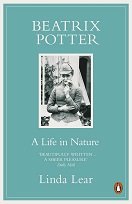Review of 'Beatrix Potter: A Life in Nature'
Beatrix Potter: A Life in Nature by Linda Lear
 Until I visited the Lake District a few years ago I had no idea that Beatrix Potter was so instrumental in the conservation of the area from development. Of course I knew her as the author of some of my favourite childhood stories such as “The Tale of Peter Rabbit” and all of her small books containing such beautiful pictures but I knew little of her life outside of writing. When you visit the area it is hard not to notice her impact with, seemingly, every “National Trust” (a non-profit organisation that maintains historic sites for the “benefit of the nation”) property something she personally donated. A visit to her “Hilltop” house near Windermere is to catch a glimpse into this highly intelligent, quirky woman seemingly ahead of her time.
Until I visited the Lake District a few years ago I had no idea that Beatrix Potter was so instrumental in the conservation of the area from development. Of course I knew her as the author of some of my favourite childhood stories such as “The Tale of Peter Rabbit” and all of her small books containing such beautiful pictures but I knew little of her life outside of writing. When you visit the area it is hard not to notice her impact with, seemingly, every “National Trust” (a non-profit organisation that maintains historic sites for the “benefit of the nation”) property something she personally donated. A visit to her “Hilltop” house near Windermere is to catch a glimpse into this highly intelligent, quirky woman seemingly ahead of her time.
In this biography, Linda Lear is exceptionally thorough in her research providing rich details of all aspects of Potter's life from her early days in London being home schooled each chapter tells how she struggled against sexist oppression of women in 19th century England and the determination of her wealthy family to see that she became the perfect Victorian woman. This was never to be with her early interest in the world around her, taking a particular interest in wildlife which she not only drew with uncanny accuracy in watercolour but also spent a great deal of time studying from a scientific perspective, particularly the reproduction of fungi. Her research was never taken seriously at the time though has since been acknowledged as being of significant importance to the scientific community.
Every summer the Potter family would set up house in various areas around the country including the Lake District where their servants and household would spend their time in typical Victorian upper-class pursuits. She rebelled at the world her parents wanted her to inhabit, wanting to find her own way in life. Beatrix would spend these trips examining the wildlife around her, growing to appreciate the natural world more and more. Her writing career started with letters she wrote to friends and family where she would tell them a small, simple story that she illustrated with simple pictures. These letters proved to be very popular so she eventually was encouraged to have them published, initially herself but then with “Frederick Warne & Co” in London, a business relationship that would last her whole life but was never entirely satisfactory to her. At Warne she eventually fell in love with her gentle, accommodating editor Norman Wayne but who sadly died only a short time after they became engaged, contrary to the wishes of her parents.
With the income from her books Beatrix was eventually able to use her own money to purchase property in the Lake District where she would live the rest of her life, eventually marrying William Heelis, a local solicitor with whom she also had business dealings. They would remain happily married for many years, largely content to let each live their own life yet having a deep love for one another. It is in this later life that Potter would spend her money purchasing more and more land that she eventually left to the fledgling National Trust and it is perhaps this legacy that we are most in debt to her for.
Though “A Life in Nature” is often quite dry with so many details crammed into it's 447 pages (plus another 100 or so pages of notes and index) this book really does seem to get to the heart of Beatrix Potter. As you read, you come to understand this woman who strived so strongly against the repression of her society and in so doing carved out a vibrant and productive life for herself. Sure, she was a woman of privilege, coming from a wealthy English family, but she was more interested in doing things for herself though would not hesitate to use family money to further her goals.
It is no doubt Beatrix Potter would have rubbed people of the time the wrong way with her forceful nature and views but we can see her impact on the world we live in today from her wonderful books to the beautiful landscape she left for all to enjoy in the Lake District. A truly exceptional individual and one who made the world a much better place.
Rating: “Nearly perfect, but not quite”
Review Date: 2021-04-02
Genre: Autobiography
Publisher: Penguin
Publication Date: 2007
ISBN: 9780141003108